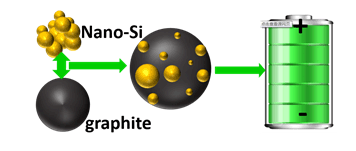| [1] (a) Whittingham, M. S. Chem. Rev. 2004, 104, 4271.
(b) Li, H.; Wang, Z.; Chen, L.; Huang, X. Adv. Mater. 2009, 21, 4593.
(c) Goodenough, J. B.; Kim, Y. Chem. Mater. 2009, 22, 587.
(d) Larcher, D.; Tarascon, J. M. Nat. Chem. 2015, 7, 19.
[2] Lv, Z.-Y.; Feng, R.; Zhao, J.; Fan, H.; Xu, D.; Wu, Q.; Yang, L.-J.; Chen, Q.; Wang, X.-Z.; Hu, Z. Acta Chim. Sinica 2015, 73, 1013. (吕之阳, 冯瑞, 赵进, 范豪, 徐丹, 吴强, 杨立军, 陈强, 王喜章, 胡征, 化学学报, 2015, 73, 1013.)
[3] Luo, F.; Zhen, J.-Y.; Chu, G.; Liu, B.-N.; Zhang, S.-L.; Li, H.; Chen, L.-Q. Acta Chim. Sinica 2015, 73, 808. (罗飞, 郑杰允, 褚赓, 刘柏男, 张素林, 李泓, 陈立泉, 化学学报, 2015, 73, 808.)
[4] Ye, Y.; Zhu, J.-Y.; Yao, Y.-N.; Wang, Y.-G.; Wu, P.; Tang, Y.-W.; Zhou, Y.-M.; Lu, T.-H. Acta Chim. Sinica 2015, 73, 151. (叶亚, 朱婧怡, 姚依男, 王雨果, 吴平, 唐亚文, 周益明, 陆天虹, 化学学报, 2015, 73, 151.)
[5] Qiu, Z.-P.; Zhang, Y.-J.; Xia, S.-B.; Dong, P. Acta Chim. Sinica 2015, 73, 992. (邱振平, 张英杰, 夏书标, 董鹏, 化学学报, 2015, 73, 992.)
[6] (a) Yoshio, M.; Wang, H.; Fukuda, K.; Umeno, T.; Abe, T.; Ogumi, Z. J. Mater. Chem. 2004, 14, 1754.
(b) Courtel, F. M.; Niketic, S.; Duguay, D.; Abu-Lebdeh, Y.; Davidson, I. J. J. Power Sources 2011, 196, 2128.
(c) Yoshio, M.; Wang, H.; Fukuda, K.; Hara, Y.; Adachi, Y. J. Electrochem. Soc. 2000, 147, 1245.
(d) Yang, S.; Song, H.; Chen, X. Electrochem. Commun. 2006, 8, 137.
[7] Liu, B.-N.; Xu, Q.; Chu, G.; Lu, H.; Yin, Y.-X.; Luo, F.; Zheng, J.-Y.; Guo, Y.-G.; Li, H. Energy Storage Sci. Technol. 2016, 5, 417. (刘柏男, 徐泉, 褚赓, 陆浩, 殷雅侠, 罗飞, 郑杰允, 郭玉国, 李泓, 储能科学与技术, 2016, 5, 417.)
[8] Lee, J. K.; Oh, C.; Kim, N.; Hwang, J. Y.; Sun, Y. K. J. Mater. Chem. A 2016, 4, 5366.
[9] Li, H.; Wang, Z.; Chen, L.; Huang, X. Adv. Mater. 2009, 21, 4593.
[10] Wilson, A. M.; Way, B. M.; Dahn, J. R.; Van Buuren, T. J. Appl. Phys. 1995, 77, 2363.
[11] Yuan, L. X.; Wang, Z. H.; Zhang, W. X.; Hu, X. L.; Chen, J. T.; Huang, Y. H.; Goodenough, J. B. Energ. Environ. Sci. 2011, 4, 269.
[12] Wu, H.; Cui, Y. Nano Today 2012, 7, 414.
[13] Li, H.; Huang, X.; Chen, L.; Wu, Z.; Liang, Y. Electrochem. Solid St. 1999, 2, 547.
[14] Choi, J. W.; Cui, Y.; Nix, W. D. J. Mech. Phys. Solids 2011, 59, 1717.
[15] Liu, X. H.; Zhong, L.; Huang, S.; Mao, S. X.; Zhu, T.; Huang, J. Y. ACS Nano 2012, 6, 1522.
[16] McDowell, M. T.; Lee, S. W.; Harris, J. T.; Korgel, B. A.; Wang, C.; Nix, W. D.; Cui, Y. Nano Lett. 2013, 13, 758.
[17] Li, J.; Dozier, A. K.; Li, Y.; Yang, F.; Cheng, Y. T. J. Electrochem. Soc. 2011, 158, A689.
[18] Gómez-Cámer, J.-L.; Bünzl, C.; Hantel, M.-M. Carbon 2016, 105, 42.
[19] Zhao, H.; Du, A.; Ling, M.; Battaglia, V.; Liu, G. Electrochim. Acta 2016, 209, 159.
[20] Lee, H.-Y.; Lee, S.-M. J. Power Sources 2002, 112, 649.
[21] Yu, H.-J.; Liu, X.-L.; Chen, Y.-X.; Liu, H.-B. Ionics 2016, 22, 1847.
[22] Dash, R.; Pannala, S. Sci. Rep. 2016, 6, 27449.
[23] Li, X.-X.; Yuan, X.-J.; Zhang, G.-Q.; Zhang, L. J. Guangdong Univ. Technol. 2014, 31, 27. (李新喜, 袁晓娇, 张国庆, 张亮, 广东工业大学学报, 2014, 31, 27.)
[24] Dimov, N.; Kugino, S.; Yoshio, M. J. Power Sources 2004, 136, 108.
[25] Wang, P.; Li, Y.-N.; Yang, J.; Zheng, Y. Int. J. Electrochem. Sci. 2006, 1, 122.
[26] Lee, H.-Y.; Lee, S.-M. Electrochem. Commun. 2004, 6, 465.
[27] Zhang, Y.; Zhang, X. G.; Zhang, H. L.; Zhao, Z. G.; Li, F.; Liu, C.; Cheng, H. M. Electrochim. Acta 2006, 51, 4994.
[28] Xu, W.; Flake, J. C. J. Electrochem. Soc. 2010, 157, A41.
[29] Zuo, P.; Yin, G.; Tong, Y. Solid State Ionics 2006, 177, 3297.
[30] Zhou, W.; Upreti, S.; Whittingham, M. S. Electrochem. Commun. 2011, 13, 158.
[31] Jo, Y. N.; Kim, Y.; Kim, J. S.; Song, J. H.; Kim, K. J.; Kwag, C. Y.; Lee, D. J.; Park, C. W.; Kim, Y. J. J. Power Sources 2010, 195, 6031.
[32] Lai, J.; Guo, H.-J.; Wang, Z.-X.; Li, X.-H.; Zhang, X.-P.; Wu, F.-X. Yue, P. J. Alloy. Compd. 2012, 530, 30.
[33] Gan, L.; Guo, H.-J.; Wang, Z.-X.; Li, X.-H.; Peng, W.-J.; Wang, J.-X.; Huang, S.-L.; Su, M.-R. Electrochim. Acta 2013, 104, 117.
[34] Yu, J.; Zhan, H.-H.; Wang, Y.-Y.; Zhang, Z.-L.; Chen, H.; Li, H.; Zhong, Z.; Su, F.-B. J. Power Sources 2013, 228, 112.
[35] Li, J.; Wang, J.-T.; Yang, J.-Y.; Ma, X.-L.; Lu, S.-G. J. Alloy. Compd. 2016, 688, 1072.
[36] Zhou, R.; Fan, R.; Tian, Z.; Zhou, Y.; Guo, H.; Kou, L.; Zhang, D. J. Alloy. Compd. 2016, 658, 91.
[37] Wang, H.; Xie, J.; Zhang, S.; Cao, G.; Zhao, X. RSC Adv. 2016, 6, 69882.
[38] Zhang, L.; Wang, Y.; Kan, G.; Zhang, Z.; Wang, C.; Zhong, Z.; Su, F. RSC Adv. 2014, 4, 43114.
[39] Kim, S.-Y.; Lee, J.; Kim, B.-H. ACS Appl. Mater. Interf. 2016, 8, 12109.
[40] Holzapfel, M.; Buqa, H.; Krumeich, F.; Novak, P.; Petrat, F. M.; Veit, C. Electrochem. Solid St. 2005, 8, A516.
[41] Jeong, S.; Lee, J. P.; Ko, M.; Kim, G.; Park, S.; Cho, J. Nano Lett. 2013, 13, 3403.
[42] Ko, M.; Chae, S.; Ma, J.; Kim, N.; Lee, H. W.; Cui, Y.; Cho, J. Nat. Energy 2016, 1, 16113. |
